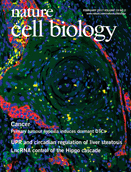Advertisement |
 |
hTERT-immortalized Cell Lines from ATCC
Enjoy the best of both worlds: the in vivo nature of primary cells & the continuous survival of cell lines. Human telomerase reverse transcriptase (hTERT) immortalized cell lines exhibit tissue-specific features, express differentiation-specific proteins, and retain consistency from experiment to experiment. Use hTERT cell lines in your disease model studies today!
Learn more>> |  | |
 |
 |
TABLE OF CONTENTS
|
February 2017 Volume 19, Issue 2 |
 |  |  |
 |  News and Views News and Views
 Articles Articles
 Letter Letter
 Corrigenda Corrigenda |  | Advertisement |  |  |  | Nature Biomedical Engineering - NOW LIVE
The first issue of Nature Biomedical Engineering is now live and available for free.
Click here to access the issue.
Remember to follow us on Twitter @NatBME or sign up to receive the e-alert. | | |
|
|
 |
|
 |
 |
| Advertisement |
 |
Nature Outlook: Lysosomal Storage Disorders
Lysosomal storage disorders are individually rare but collectively common. The study of these diseases is not only leading to better treatments, but also revealing many of the secrets of this underappreciated organelle.
Access the Outlook >
Produced with support from:
Alexion Pharmaceuticals, Inc.
Ultragenyx Pharmaceutical Inc.
Produced with support of a grant from:
Shire plc
BioMarin Pharmaceutical Inc | | |
 |
| |
Advertisement |
 |
An open access journal dedicated to highlighting the most important scientific advances in Parkinson's disease research, spanning the motor and non-motor disorders of Parkinson's disease.
Part of the Nature Partner Journals series, npj Parkinson's Disease is published in partnership with the Parkinson's Disease Foundation.
Open for submissions >> |  | |
 |
| |
News and Views |  Top Top |
 |
 |
 |
|
 |
| Advertisement |
 |
Thousands of single cells. One solution.
From the industry leaders in sequencing and Droplet Digital™ technologies, Illumina and Bio-Rad provide a robust, scalable, and user-friendly workflow enabling transcriptome profiling of hundreds to tens of thousands of single cells. |  | |
 |
| |
Articles |  Top Top |
 |
 |
 |
Actin dynamics and competition for myosin monomer govern the sequential amplification of myosin filaments pp85 - 93
Jordan R. Beach, Kyle S. Bruun, Lin Shao, Dong Li, Zac Swider et al.
doi:10.1038/ncb3463
Using structured illumination microscopy, Beach et al. and Hu et al. visualize the assembly of myosin II filaments in cells, describing a filament-partitioning mechanism, and long-range self-organization of filaments, respectively.
See also: Letter by Hu et al. | News and Views by Titus |
 |
 |
 |
Circadian- and UPR-dependent control of CPEB4 mediates a translational response to counteract hepatic steatosis under ER stress pp94 - 105
Carlos Maillo, Judit Martín, David Sebastián, Maribel Hernández-Alvarez, Mar García-Rocha et al.
doi:10.1038/ncb3461
Maillo et al. show that in hepatocytes ER stress upregulates CPEB4 through the UPR and circadian clock, leading to CPEB4-mediated translation for mitochondrial and ER homeostasis. CPEB4 loss leads to ageing- and high fat diet-induced liver steatosis.
See also: News and Views by Moore & Oakes |
 |
 |
 |
A ROR1–HER3–lncRNA signalling axis modulates the Hippo–YAP pathway to regulate bone metastasis pp106 - 119
Chunlai Li, Shouyu Wang, Zhen Xing, Aifu Lin, Ke Liang et al.
doi:10.1038/ncb3464
Li et al. show that ROR1–HER3 receptor tyrosine kinase signalling in breast cancer cells inhibits the MST1/2 Hippo pathway kinases through a lncRNA termed MAYA. The resulting activation of YAP promotes osteoclast differentiation for bone metastasis.
See also: News and Views by Zhuo & Kang |
 |
 |
 |
Phenotypic heterogeneity of disseminated tumour cells is preset by primary tumour hypoxic microenvironments pp120 - 132
Georg Fluegen, Alvaro Avivar-Valderas, Yarong Wang, Michael R. Padgen, James K. Williams et al.
doi:10.1038/ncb3465
Aguirre-Ghiso and colleagues report that hypoxia in the primary tumour microenvironment leads to upregulation of a dormancy signature in the tumour cells that persists after their dissemination to distant sites, permitting them to evade therapy. |
 |
| Advertisement |
 |
nature.com webcasts
Pixels to data: Quantitative cell biology using high-content imaging and analysis.
Date: Tuesday 28 February 2017
Time: 8AM PST, 11AM EST, 4PM GMT, 5PM CET
Register
Sponsor:
PerkinElmer | | |
 |
| |
Letter |  Top Top |
 |
 |
 |
Long-range self-organization of cytoskeletal myosin II filament stacks pp133 - 141
Shiqiong Hu, Kinjal Dasbiswas, Zhenhuan Guo, Yee-Han Tee, Visalatchi Thiagarajan et al.
doi:10.1038/ncb3466
Using structured illumination microscopy, Beach et al. and Hu et al. visualize the assembly of myosin II filaments in cells, describing a filament-partitioning mechanism, and long-range self-organization of filaments, respectively.
See also: Article by Beach et al. | News and Views by Titus |
 |
Corrigenda |  Top Top |
 |
 |
 |
Corrigendum: Clonal fate mapping quantifies the number of haematopoietic stem cells that arise during development p142
Jonathan Henninger, Buyung Santoso, Stefan Hans, Ellen Durand, Jessica Moore et al.
doi:10.1038/ncb3462 |
 |
 |
 |
Corrigendum: Mitotic internalization of planar cell polarity proteins preserves tissue polarity p143
Danelle Devenport, Daniel Oristian, Evan Heller and Elaine Fuchs
doi:10.1038/ncb3469 |
 |
 Top Top |
 |
 |
 |  |  |  |  |  | Natureevents is a fully searchable, multi-disciplinary database designed to maximise exposure for events organisers. The contents of the Natureevents Directory are now live. The digital version is available here.
Find the latest scientific conferences, courses, meetings and symposia on natureevents.com. For event advertising opportunities across the Nature Publishing Group portfolio please contact natureevents@nature.com |  |  |  |  |  |
|
 |


No comments:
Post a Comment